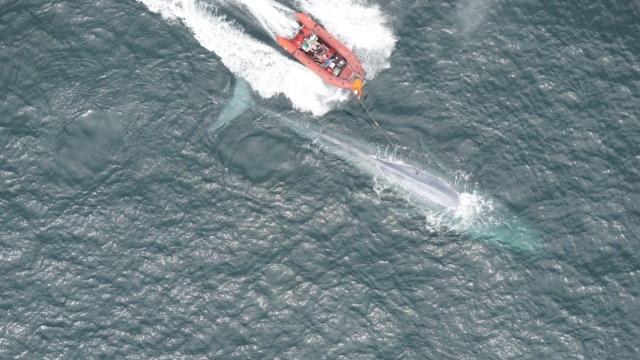For the first time ever, marine biologists have recorded the heart rate of a blue whale in the wild—the results of which even surprised the scientists.
New research published Monday in Proceedings of the U.S. National Academy of Sciences is the first to provide a heart rate profile for free-ranging blue whales. The resulting data shows how the hearts of these enormous cetaceans help them hold their breath for prolonged periods of time as well as how they’re suddenly able to exert the energy needed for lunge feeding and then replenish their blood oxygen levels when back at the surface.
At the same time, the new study, co-authored by marine biologist Jeremy Goldbogen from the School of Humanities Sciences at Stanford University, suggests the blue whale has reached the largest size possible for an aquatic organism on Earth. The cardiovascular system of the blue whale, while impressive, is probably the limit of what is biologically possible, according to the new research.
Blue whales are the largest creatures to have ever lived on the planet. These aquatic mammals can reach upwards of 30 metres in length and weigh an astonishing 173 metric tons (172,365 kilograms). To put this into perspective, that’s equal to about 292 very heavy African elephants—currently the largest terrestrial animal on Earth.
Living in the ocean is what allow blue whales to grow to such an enormous size possible, as no creature of that immensity could possibly support itself on land. The largest land animals to have ever lived were the titanosaurs, a group of four-legged, long-necked dinosaurs that included Argentinosaurus, Brontosaurus, and Rapetosaurus. These herbivores got as long as 15 metres and weighed nearly 82 metric tons (82,000 kilograms). They were big, no doubt about it, but not nearly as big as the blue whale.
The new research notes that another important factor allowing blue whales to grow so large is their highly specialised cardiovascular system. For marine biologists, however, understanding exactly what makes the blue whale’s heart tick has proven difficult given they’re almost too big to measure. To overcome this hurdle, Goldbogen and his colleagues developed an electrocardiogram (ECG) tag that they attached to a blue whale with suction cups.
That’s right—suction cups.
“I honestly thought it was a long shot because we had to get so many things right: finding a blue whale, getting the tag in just the right location on the whale, good contact with the whale’s skin and, of course, making sure the tag is working and recording data,” said Goldbogen in a press release.
The researchers managed to attach their device next to the flipper of a 15-year-old male blue whale in Monterey Bay, California. The device tracked the rhythms of the whale’s heart as it dove to depths of 184 meters (604 feet), and as it stayed underwater for nearly 17 minutes at a time.
Looking at the results, the researchers were able to chronicle the blue whale’s heart rate as it went about its daily routine. When the whale made a deep dive, its heart rate slowed to a crawl, beating around 4 to 8 beats per minute (bpm) on average, and sometimes as slow as two beats per minute (the normal resting heart rates for humans is between 60 to 100 bpm). With this radically diminished heart rate, the whale was able to conserve its blood oxygen supply, allowing it to stay underwater for prolonged periods of time and maximise foraging time.
When foraging for food, filter-feeding blue whales perform energetic lunges to gobble up large volumes of seawater filled with tiny prey. Looking at the ECG results, the blue whale’s heart rate jumped appreciably during these foraging lunges, beating around two-and-a-half times more compared to its slowest rate or bradycardia. This was a demonstration of the whale’s remarkably flexible cardiovascular system, allowing it to perform at the extremes of nature.
Once the whale returned to the surface, its heart rate jumped further still, beating at between 25 to 27 bpm on average. Known as tachycardia, this is when the whale worked to replenish its supply of blood oxygen.
The heart rate profile for the blue whale came as a surprise even to the researchers. The observed bradycardia was 30 to 50 times lower than expected. The low rate was made possible by an elastic-like part of the whale’s body called an aortic arch, according to the new paper. This remarkable piece of whale anatomy transports blood to the outer reaches of the whale’s gigantic body, contracting slowly to maintain blood flow during the long interval between beats. The heart’s unique pulsations and shape keeps blood flowing and is what makes the whale’s higher heart rate possible.
During tachycardia, the blue whale’s heart rate is likely working at the highest maximum limit allowable by the constraints of biology, according to the authors. A more robust cardiovascular system is not likely, they argue, and the new research may actually explain why no species on Earth has grown bigger than the blue whale.
Looking ahead, the researchers would like to used accelerometers to monitor the speed of the blue whales in relation to their heart rate. They’d also like to use their ECG suction cup device to measure the heart rate of fin whales, humpback whales, and minke whales.
